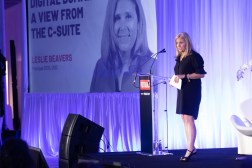What DOD’s new Fulcrum IT strategy means for warfighters

The Defense Department’s 15-page plan to guide military and civilian components’ sprawling information technology activities and objectives in fiscal years 2025 through 2029 places a sharp focus on user experience and lays out concrete metrics to track tangible progress.
Now, following the official release of DOD’s new Fulcrum: IT Advancement Strategy on Tuesday, the Chief Information Office-led team that shaped it is moving to mobilize an enterprisewide commitment to the four, integrated directions the blueprint is organized around.
“I’m going to spend the rest of this calendar year making sure that we put in place the right governance structure to help oversee synchronizing the department to move out and deliver in these lines of effort,” Principal Deputy Chief Information Officer Leslie Beavers explained.
In an exclusive interview with DefenseScoop to preview Fulcrum ahead of its publication, Beavers shed light on Pentagon leadership’s vision for carrying out this next-generation IT strategy and what its realization could really look like for DOD.
“It was really important to crystallize the department’s vision into what success looks like, which is what we are attempting to do here in Fulcrum because I am trying to get program managers across the department — not just within the CIO organizations, but in all the different weapon systems program offices — to make decisions a little differently, to make them with the user experience in mind, to make them with interoperability as a priority first and really defining what success looks like, and giving them that vision,” she said.
Lean Six Sigma
CIO leaders aim to expedite DOD’s evolution from a hardware-defined to a more flexible, software-defined enterprise through Fulcrum, which builds on the flagship 2019 defense modernization strategy.
“This is really representing a maturation of that strategy. We were at the five-year point [in] the tech industry, the modernization journey — that’s why it’s not a new strategy. It’s an advancement of the previous strategy. It’s taking into account the new technologies that have been developed and, kind of, the changing world situation and how we are just providing that kind of refreshed vision for how we need to move out in the department in the next five years,” Beavers told DefenseScoop.
Unlike heaps of prior federal strategies, she deliberately ensured that this one wasn’t nicknamed with an abbreviation.
“I didn’t want an acronym — another DMS [for defense modernization strategy], or something like that. That just doesn’t inspire you to, like, want to read it,” Beavers said.
She opted to host “a little competition” amongst DOD colleagues to encourage a creative name for the new guide.
“Whoever came up with the name that I chose, I took to lunch. There were over 40 people involved in writing this document, by the way, from across the department. So this isn’t just Leslie-, or even CIO-team generated. This is a Department of Defense team-generated strategy. And because Fulcrum is at the pivot point between the national security strategies and the defense strategies, how do we translate those strategies into specific actions to take within the department to deliver those capabilities? That’s why Fulcrum really resonated with me when it was one of the proposals,” Beavers explained.
In the interview, she emphasized that professionally she intentionally pursues a “Lean Six Sigma” managerial approach.
“You start with the customer experience first, and what are you trying to deliver for the end user or the customer? In this case, it’s the warfighter — and my experience over the years with being a reservist and having a lot of connectivity challenges is one of the main reasons why I’m here. So starting with, what does it feel for the warfighter? How we function from a warfighter perspective is most important,” Beavers said.
In her view, the U.S. combatant commands are Fulcrum’s primary end users.
“We are very closely partnered with the Joint Staff, J6. I look at them as our main conduit into the combatant commands. And when I say ‘warfighter,’ I’m thinking of everybody, from at the combatant command headquarters all the way out to the soldier, or the Marine sitting on an island, isolated somewhere,” Beavers said.
Broadly, the Fulcrum strategy is structured around four lines of effort that the document states represent “a strategic shift that embraces technology as a mission enabler.” They include:
- LOE 1: Provide Joint Warfighting IT capabilities to expand strategic dominance of U.S. Forces and mission partners.
- LOE 2: Modernize information networks and compute to rapidly meet mission and business needs.
- LOE 3: Optimize IT governance to gain efficiencies in capability delivery and enable cost savings.
- LOE 4: Cultivate a premier digital workforce ready to deploy emerging technology to the warfighter.
Each of those lines is also supported by a series of strategic objectives that span Pentagon portfolios, which further detail the envisioned way ahead — and indicate clear, measurable mechanisms to trace teams’ progress.
“This really translates strategic vision into tangible actions that the warfighter should feel,” Beavers said.
Typically, government strategies don’t go “down to that level,” she added. But on Beavers’ part, this was purposeful — drawing from her unique background in the government and major corporations, like GE Healthcare and NBCUniversal.
“[Often] in industry, the pervasive opinion is that if you don’t know your numbers, you don’t know your business. And in the [DOD], we know certain numbers. But I’m trying to really grow the kind of awareness all the way down into the organization — beyond just the CIO, or beyond just the senior leaders — to get after making tangible progress that they can tell the story on so that they can get the right resources to continue to grow,” the deputy CIO said. “These modernization initiatives and IT have not always been at the forefront of people’s minds as important things to fund, and they really, I think, should be.”
Notably, the launch of this new pathway and plan comes as the Pentagon and military are working hard to realize a number of next-generation initiatives, including but not limited to those to enable the Joint Warfighting Cloud Capability (JWCC), Combined Joint All-Domain Command and Control (CJADC2), and an enterprise-wide cybersecurity approach based on the contemporary concept for zero-trust.
“We’re facing a whole-of-nation threat, and it requires a whole-of-government, whole-of-nation response,” Beaver noted.
She continued: “So, I really want to foot-stomp that we’re only as good as our weakest link, especially in the cyber world. Taking to heart the cybersecurity and interoperability functionality — that — I need everybody to work on. This is not something that we can do by ourselves. Within the IT workforce, we’re less than 10% of the total workforce. We can’t do it for everybody, so we’ve got to have everybody pile on and help. If they are willing to give me a little bit of time and read Fulcrum, it’s a short read, but it would be very helpful.”
‘The Big Uglies’
Beavers’ unique professional experience spans decades and disciplines.
Her defense career began as an Air Force intelligence officer, and she ultimately retired as a reserve brigadier general. Before she took on this position within the Office of the CIO, she served as the director of intelligence surveillance and reconnaissance enterprise capabilities (ISREC) — where she led Project Herald, the under secretary of defense for intelligence and security’s Defense Intelligence Digital Transformation Campaign.
“That work absolutely influenced the Fulcrum work, because we just built on what we learned from Herald and scaled it up to the department. And so, we did have a lot of participation across the board,” Beavers noted.
It took six months for dozens of DOD officials to develop, refine and agree upon the final version of the Fulcrum strategy.
“It’s lightning fast [for DOD],” Beavers said.
“I didn’t want a strategy that was in the silos. I needed something that was cross-cutting about delivering for the customer and that user experience, that customer focus is throughout the document. And to do that, you have to think of the outcomes. So, I started assembling that team in January. We really kind of rolled our sleeves up and had 40 people in a room working on it,” she explained.
Outside of her military career, Beavers’ leadership approach is also informed by more than 15 years of experience in multiple private sector industries — including as a vice president at NBC/Universal Pictures tasked with recovering 80 years of broadcast content destroyed in a fire.
“I tend to gravitate towards what I call the ‘big uglies,’ which is a quote that comes out of Disney’s Three Musketeers. Oliver Platt’s character says that when he runs into this guy in the dungeon, he’s like, ‘Oh, big ugly!’ and turns around and runs away,” she explained.
“But I’m the one that stands there and tries to sort out the big uglies and take on the areas that I think are foundational and really important, but maybe don’t get the attention that other kind of flashier options to work on,” Beavers said.
Though she did not refer to it in this way herself, one could argue that a Pentagon-central “big ugly” that influenced Fulcrum was the viral “Fix Our Computers” push.
“I think it’s a natural response. I would have done it without the Fix Our Computers campaign anyway, because I’m in the Fix Our Computers campaign — like, that’s what I’ve experienced. So we are, within the department, very aware of that challenge,” she said.
Now that Deputy Defense Secretary Kathleen Hicks signed off on this new strategy, Beavers and her team are shifting to a phase where they intend to, as she put it, “mobilize the department-wide commitment to” executing on each of its four guiding inclusions.
“To do that, I’m going to highlight at least one area within each of the LOEs to champion and make sure that the governance processes that I oversee align with driving progress within that area. And so I’m working with the team on that, but [Mission Partner Environments, or MPEs] kind of very top of the list. The cyber workforce is top of mind,” she explained.
Officials involved are also generating even deeper, specific metrics that will be an annex to the overarching plan.
“So for example, if you’re saying, ‘Well my cloud implementation is pretty good, but I want to work on my cyber workforce stuff, what are the metrics? What should I be doing to develop that?’ So that will be coming out,” Beavers said.
Another in-the-works resource that will soon accompany Fulcrum is an associated implementation plan meant to firm up a distinct framework for carrying out the DOD’s fresh strategic vision.
“Then I’ll pick a few flagship efforts to champion, personally, to demonstrate for the department how to do this. Within the DOD, we’re pretty resourceful — and the whole ‘improvise, adapt and overcome’ [notion] is part of our DNA. When you do have these kinds of flagship efforts, other people will pile on. And so I’ll be looking for that to start happening. I think that’ll take another six or eight months before I’ll start seeing a pile on, but that’ll be my next benchmark,” Beavers told DefenseScoop.






